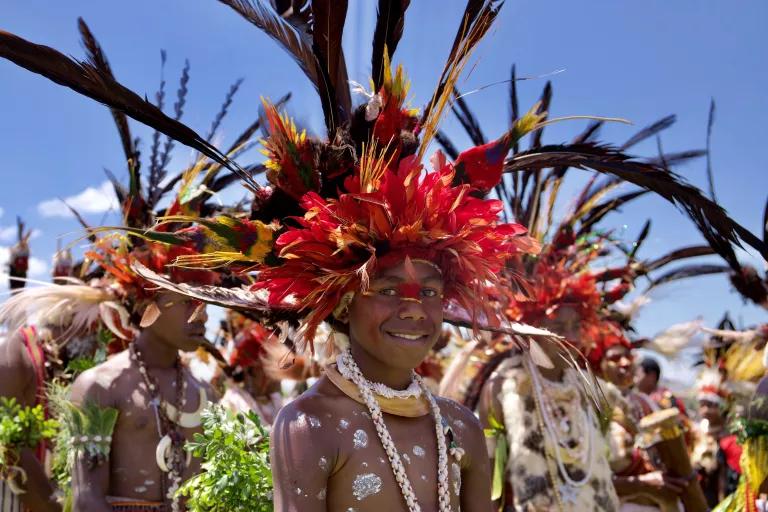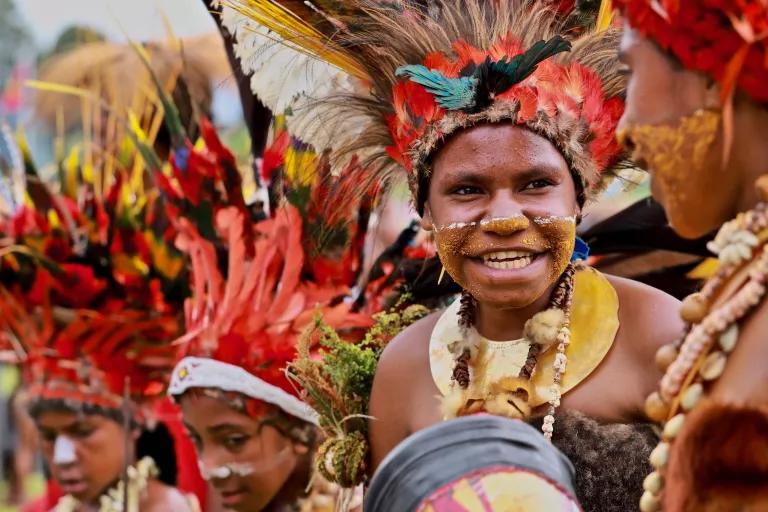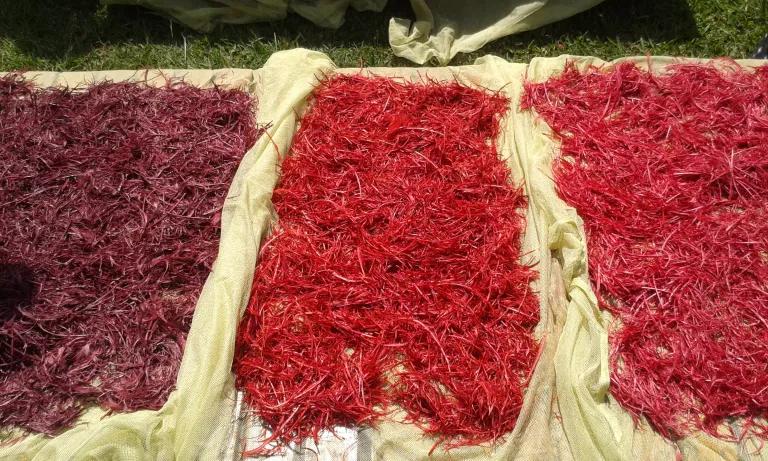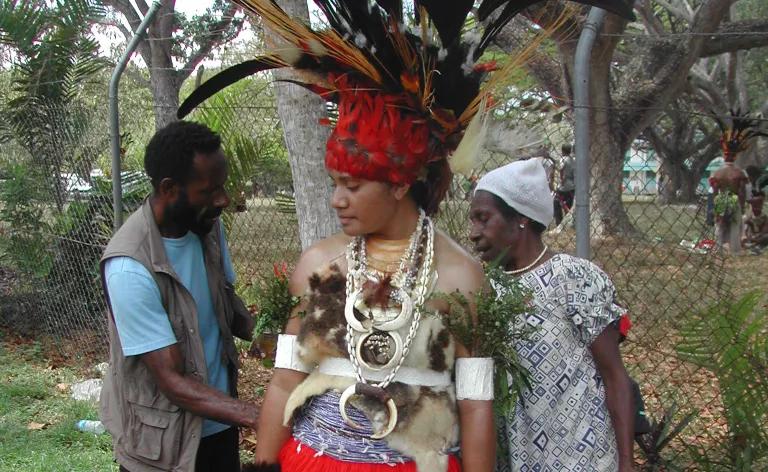Preserving Dead Parrots in Order to Save the Living
The people of Papua New Guinea treasure feathers from the Pesquet’s parrot for use in ceremonial headdresses. But the practice could be driving the birds to extinction.

The Pesquet’s parrot
Grace Nugi is a woman caught between two worlds. On one hand, Nugi is a conservation biologist determined to save the wildlife of Papua New Guinea. On the other, she’s trying to preserve a piece of her people’s heritage—the tradition of wearing stunning, three-foot-tall ceremonial headdresses and outfits known as bilas. The problem is that the bilas are made almost entirely of wild bird feathers.
The Pesquet’s parrot is one of those birds. Also known as the vulturine parrot, it has a featherless face, which is thought to help it avoid getting too sticky from its diet of ripe figs. The rest of the parrot is shiny black, except for a patch of brilliant red feathers on its belly that have become popular in the bilas trade. There’s no question that the crimson feathers of a Pesquet’s parrot really make a headdress pop, but the demand for them has put the species on the path to ruin. The parrot’s plight has earned it a “vulnerable to extinction” label from the International Union of Conservation of Nature.
According to a new study led by Nugi and published in the journal Emu—Austral Ornithology, there are now more Pesquet’s parrots present in ceremonial headdresses than there are remaining in the wild. And because headdresses degrade over time, trappers continue to capture birds to make new ones. Because the birds nest in tree cavities, using the same hole again and again, trappers can follow the birds back to their nests to ensnare them. In just one district of Chimbu province, a survey found that approximately 3,200 Pesquet’s parrots would be required to meet the demand for new bilas materials each year. That’s around 8 percent of the entire remaining population.
Passing laws to save this particular parrot, unfortunately, would be challenging. Pesquet’s parrots eat figs to the exclusion of almost everything else, and they travel far to find the energy-packed fruits. So any efforts to protect the areas that the parrots frequent would have to be wide-ranging, which in turn would be quite costly and, frankly, probably doomed to failure.
“It’s just too expensive to try and do in situ, site-based conservation for this species,” says study coauthor Nathan Whitmore, a biologist at the Wildlife Conservation Society (WCS), who was also featured in a 2015 Species Watch story about gloriously green snail shells. “You’d have to go over thousands, tens of thousands of square kilometers to make any difference.”
So scientists are recommending a different conservation strategy altogether. Instead of trying to save the birds in the forest, they are focusing on protecting what’s left of the dead birds on peoples’ heads.
“The most practical and realistic way to start off is for people to preserve the headdresses they already have,” says Nugi, who is also a WCS scientist and the lead author of the study.
The good news is that Papua New Guineans already have some incentive to make their ceremonial garb last: it’s costly. Three parrots are killed to get enough feathers for just one of these headdresses. The birds live in the country’s lowlands, but the greatest demand for them is in the highlands, so people don’t generally go out into the forest and catch parrots on their own. Instead they buy the feathers from traders, at a cost of 90 kina, or around $34. “This is a substantial sum for a rural person living a subsistence lifestyle in a country where 38 percent of people live below the national poverty line,” writes Nugi in the study.


After busting the bilas out for a guest-welcoming or bridal ceremony (most are worn just once or twice a year), many owners deconstruct their headdresses and sheath the feathers in bamboo in order to protect their investment. The whole apparatus is typically stored in the rafters of the owner’s home, where fire from the family’s hearth keeps it dry and less prone to mold. This storage method, however, can leave the garments vulnerable to rodents, moths, and other insects. Some people even wrap their bilas in plastic and paper and put them in storage containers, if they have access to them.
With that in mind, WCS–Papua New Guinea has begun handing out Bilas Protection Kits to anyone who will take them. The kits are basically just better versions of the storage materials already in use: strong plastic bags and mothballs designed to keep pests away. The kits are relatively inexpensive to create, and the conservationists hand them out at events where people sport bilas, such as the country’s largest cultural event, a sing-sing known as the Goroka Cultural Show held each September. The real cost comes in getting the kits to the areas that need them, and in numbers sufficient to make a difference.
“You’ve got around 720,000 people just in the two main provinces of Chimbu and Jiwaka. And to have a real effect, we need to be giving these kits out to virtually everybody in those provinces,” says Whitmore.
Whether these kits are making a difference is difficult to say because, as Whitmore puts it, you’d need “a mountain of money” to determine exactly how many Pesquet’s parrots remain. What we do know is that Papua New Guinea’s human population is increasing at a rapid pace of 2 percent annually, which means the number of people who may want to participate in bilas culture could potentially double over the next 35 years.

Nugi says the demographic forecast is all the more reason to do what we can to extend the life of each headdress that’s already out there. With proper care, they can last 15 to 20 years. So even tiny extensions of that lifespan will have real consequences for bird populations over the decades.
Nugi doesn’t own a headdress herself, nor does her mother. But she does borrow bilas from her aunties or grandmother for special occasions. And each time she does, she incurs a hefty cost, because she has to fly one of her relatives out to her location to fit the outfit to her and help her put it on.

“The headdresses and the whole adornment and attire, it’s a huge part of our cultural identity,” says Nugi, who happens to hold the title of former Miss Papua New Guinea. But that identity is fluid. Records show that Pesquet’s parrot feathers weren’t used in bilas at all in the 1930s and have gained prominence only since the 1960s. Likewise, bilas were once made out of just a handful of species but today can include feathers from 10 or more different kinds of birds. And while Nugi says her parents’ generation had started to move away from wearing the headdresses, the younger generations are donning bilas more than ever. The headdresses are now a common sight at graduation ceremonies, for instance, even though that was not a traditional time for wearing them in the past.
But increased interest in the headwear may have kick-started more sustainable ways of sourcing feathers. Some people now use introduced species, such as peacock, or they even dye regular old white chicken feathers red instead of paying the price for authentic Pesquet’s parrots.
“Culture is changing all the time,” says Nugi. “And I think it’s a struggle for us trying to keep up with change, as well as to just hold on to something that we value.” That goes for Papua New Guinea’s wildlife, too.
This article was originally published on onEarth, which is no longer in publication. onEarth was founded in 1979 as the Amicus Journal, an independent magazine of thought and opinion on the environment. All opinions expressed are those of the authors and do not necessarily reflect the policies or positions of NRDC. This article is available for online republication by news media outlets or nonprofits under these conditions: The writer(s) must be credited with a byline; you must note prominently that the article was originally published by NRDC.org and link to the original; the article cannot be edited (beyond simple things such grammar); you can’t resell the article in any form or grant republishing rights to other outlets; you can’t republish our material wholesale or automatically—you need to select articles individually; you can’t republish the photos or graphics on our site without specific permission; you should drop us a note to let us know when you’ve used one of our articles.

These 5 Animals Would Be Goners Without the Endangered Species Act
Finally, a High Seas Treaty to Protect the World’s Oceans
Can Anything Be Done to Stop Overfishing?